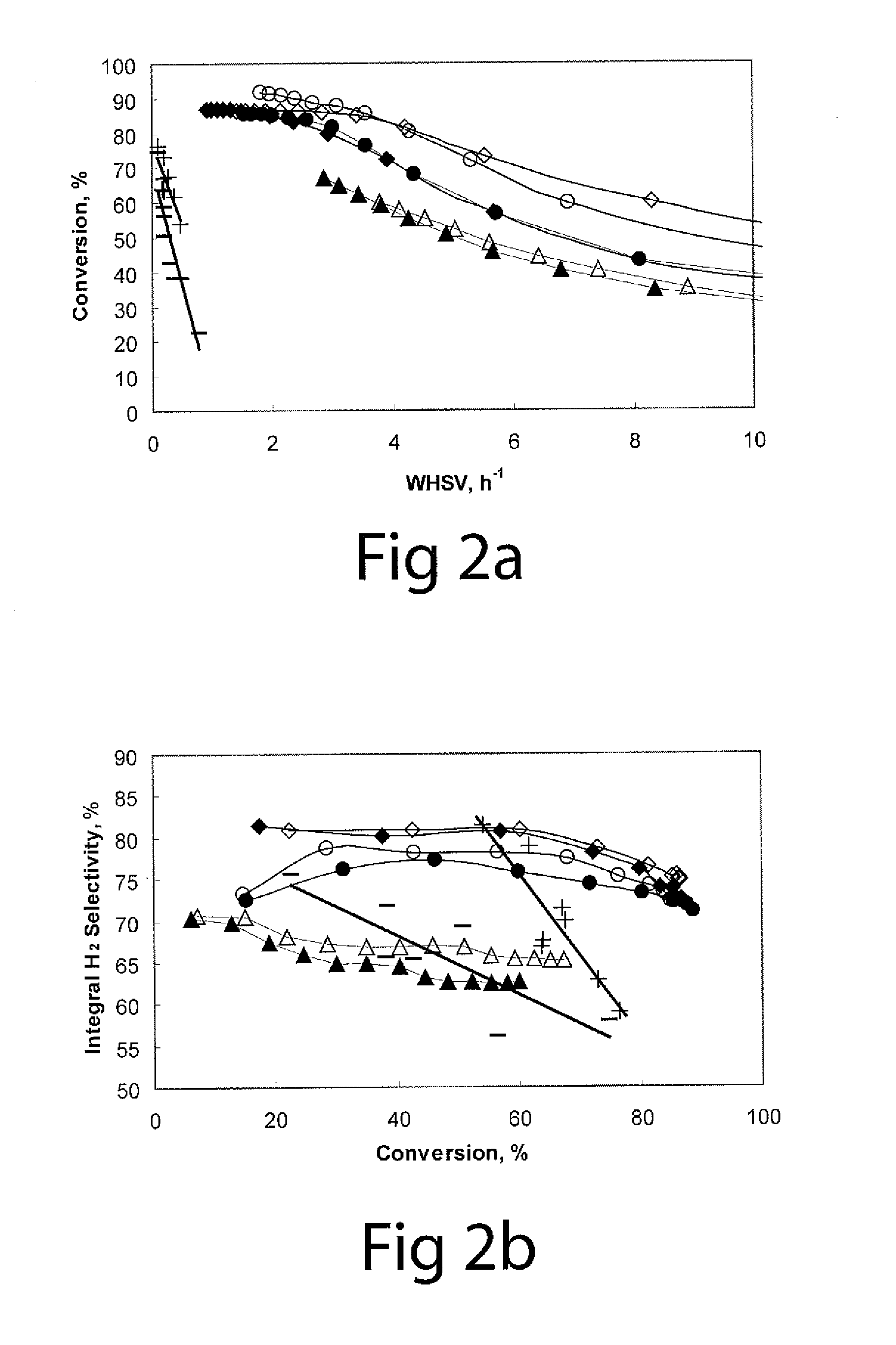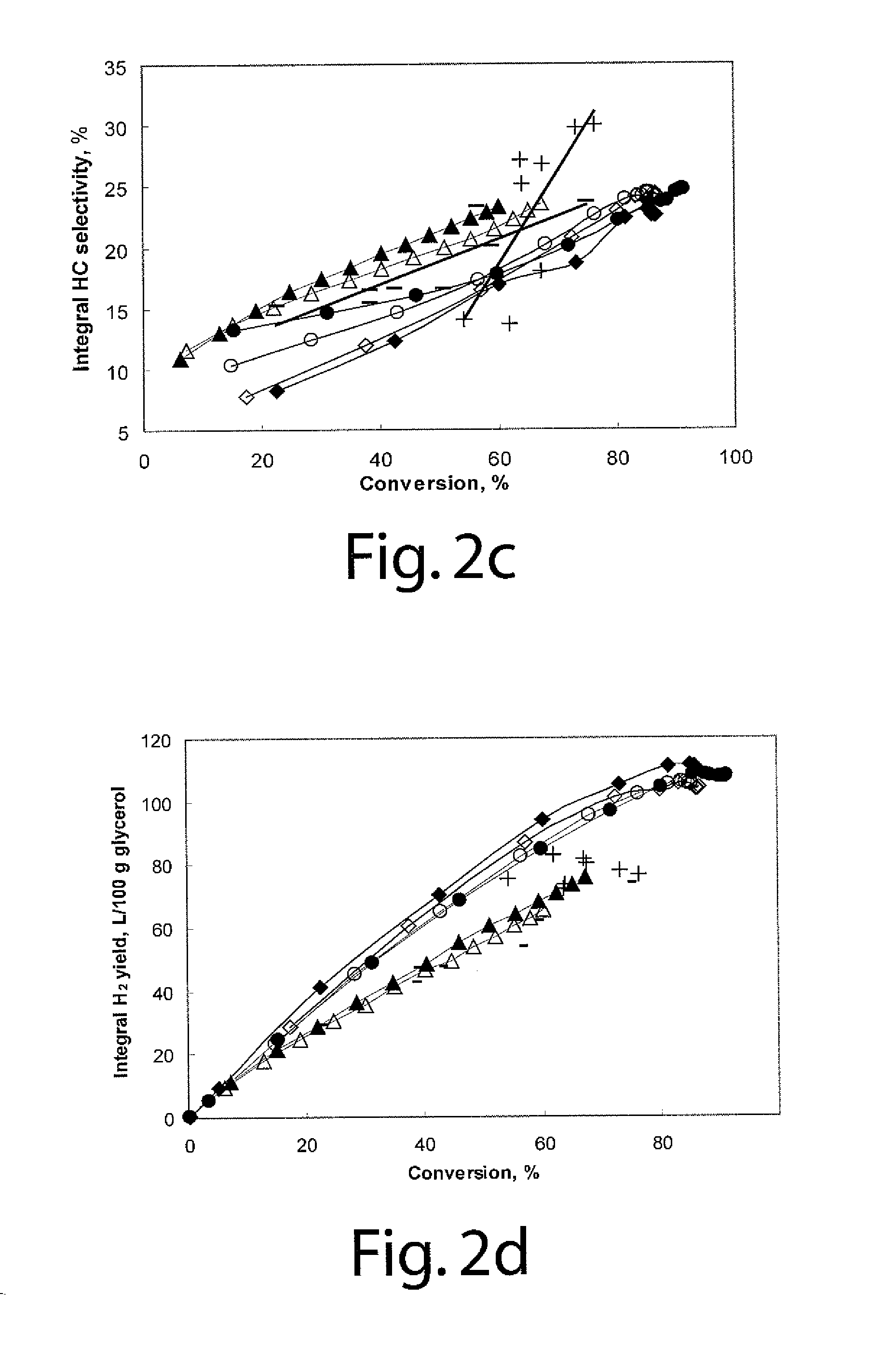Production of hydrogen from oxygenated hydrocarbons
a technology of hydrogen fuel cells and hydrocarbons, which is applied in the field of hydrogen production from oxygenated hydrocarbons, can solve the problems of low hydrogen production rate, low impact on the environment of hydrogen fuel cells, poor economics, etc., and achieve the effect of high surface area
- Summary
- Abstract
- Description
- Claims
- Application Information
AI Technical Summary
Benefits of technology
Problems solved by technology
Method used
Image
Examples
example 1
Performance of Pt Catalysts
[0046]To compare two types of catalytic reactors, the performance of glycerol aqueous phase reforming on 3 wt % Pt / γ-Al2O3 catalysts in both the semi-batch stirred tank reactor and a fixed bed tubular reactor is plotted in FIGS. 2a to 2d.
[0047]FIG. 2a is a graph showing conversion versus WHSV using Pt catalysts (10 wt % glycerol aqueous solution as reactant at 538° K (265° C.) and 900 psig); the filled and empty symbols stand for two repeat runs using 3 wt % Pt / γ-Al2O3 catalysts; symbols ⋄ and ♦ show the results for 150-250 μm particles; symbols ∘ and show the results for 250-300 μm particles; symbols Δ and ▴ show the results for 590-850 μm particles; symbol + shows the results for 3 wt % Pt / γ-Al2O3 catalyst (300-850 μm) tested in fixed bed tubular reactor (FBTR); and symbol − shows the results for 1 wt % Pt / γ-Al2O3 catalyst (300-850 μm) tested in the FBTR.
[0048]FIG. 2b is a graph showing integral hydrogen selectivity versus glycerol conversion using Pt...
example 2
Performance of Nickel Catalysts
[0059]Catalysts 20 wt % and 40 wt % Ni / γ-Al2O3 were also tested using the semi-batch stirred tank reactor. Based on results obtained for 3 wt % Pt catalysts indicating that the performances of catalysts having small particle size were better, γ-Al2O3 support between 150-250 μm size were used to prepare 20 wt % and 40 wt % Ni / γ-Al2O3 catalysts. Experimental results are plotted in FIGS. 3a to 3d which are described as follows.
[0060]FIG. 3a is a graph showing conversion versus WHSV using Ni catalysts (10 wt % glycerol aqueous solution as reactant at 548° K (275° C.) and 900 psig). The filled and empty symbols stand for two repeat runs. Symbols Δ and ▴ show results for 40 wt % Ni catalysts (150-250 μm); symbols □ and ▪ show the results for 20 wt % Ni catalyst (150-250 μm); symbol ∘ shows the results for 20 wt % Ni / γ-Al2O3 catalyst (300-850 μm) tested in fixed bed tubular reactor (FBTR); and symbol * shows the results for 40 wt % Ni / γ-Al2O3 catalyst (300-85...
PUM
| Property | Measurement | Unit |
|---|---|---|
| pressure | aaaaa | aaaaa |
| temperature | aaaaa | aaaaa |
| pressure | aaaaa | aaaaa |
Abstract
Description
Claims
Application Information
 Login to View More
Login to View More - R&D
- Intellectual Property
- Life Sciences
- Materials
- Tech Scout
- Unparalleled Data Quality
- Higher Quality Content
- 60% Fewer Hallucinations
Browse by: Latest US Patents, China's latest patents, Technical Efficacy Thesaurus, Application Domain, Technology Topic, Popular Technical Reports.
© 2025 PatSnap. All rights reserved.Legal|Privacy policy|Modern Slavery Act Transparency Statement|Sitemap|About US| Contact US: help@patsnap.com



